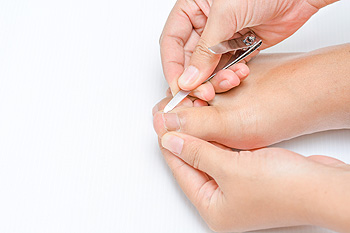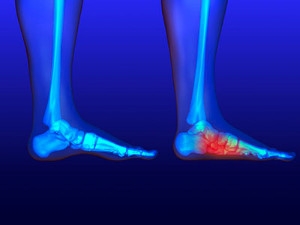
What to Know About a Broken Toe
The forefoot is composed of five metatarsal bones and fourteen phalanges. Each toe has three phalanges except for the big toe which only has two. Our toes play an essential role to the walking process, which is why a broken toe could seriously disrupt one’s ability to move around. Toe fractures are common and can be very painful. Fortunately, these injuries rarely require surgery and usually heal with rest and a change in activity.
Broken toes typically result from a traumatic event such as falling, stubbing the toe, or dropping something on the toe. Traumatic toe fractures may be categorized as either minor or severe fractures. At times, one may hear a “pop” or “crack” sound when the bone breaks. Common symptoms of a traumatic toe fracture include pain, throbbing, bruising, swelling, and redness.
Another type of toe fractures is a stress fracture. These injuries usually appear in the form of small hairline breaks on the bone. Stress fractures develop after repetitive activity instead of a single injury. Stress fractures occur when the muscles in the bone become too weak to absorb impact. Consequently, the toe bone becomes vulnerable to any pressure and impact it endures. Symptoms for a stress fracture in the toe include swelling without bruising, tenderness to the touch, pain that goes away with rest, and pain after walking or running.
If you suspect that you have a broken toe, you should make an appointment with your podiatrist. He or she will likely diagnose you by performing a physical exam and an X-ray. Treatment for a broken toe may include the R.I.C.E. method, buddy taping, surgery, or antibiotics. The R.I.C.E. method (Rest, Ice, Compression, and Elevation) is a common treatment method for many injuries because it decreases pain. Buddy tapping involves wrapping the injured toe next to an adjacent toe to keep it supported and protected. These two methods have proven to be effective in the healing process for toe fractures. The estimated healing time for a broken toe is approximately four to six weeks. If the injury becomes infected or requires surgery, the estimated healing time may take eight weeks or more.
Is Foot Pain Common?
 Many people have experienced foot pain at some point in their lives. There are many different forms of this type of pain, and it may come from a variety of reasons. If you have heel pain, you may have what is known plantar fasciitis. This happens when the tissue that connects the heel to the toes becomes inflamed, and pain is typically felt in the heel or on the sole of the foot. If there is discomfort and pain under the toes near the ball of the foot, a condition that is referred to as metatarsalgia may be present. This may develop as a result of frequently participating in running and jumping activities, which may put stress on that part of the foot. If you have pain at the bottom of the big toe, you may have a condition that is known as turf toe. This is considered to be a sprain of the big toe. If you are having any type of foot pain, it is suggested to consult with a podiatrist who can properly treat any foot ailments you may have.
Many people have experienced foot pain at some point in their lives. There are many different forms of this type of pain, and it may come from a variety of reasons. If you have heel pain, you may have what is known plantar fasciitis. This happens when the tissue that connects the heel to the toes becomes inflamed, and pain is typically felt in the heel or on the sole of the foot. If there is discomfort and pain under the toes near the ball of the foot, a condition that is referred to as metatarsalgia may be present. This may develop as a result of frequently participating in running and jumping activities, which may put stress on that part of the foot. If you have pain at the bottom of the big toe, you may have a condition that is known as turf toe. This is considered to be a sprain of the big toe. If you are having any type of foot pain, it is suggested to consult with a podiatrist who can properly treat any foot ailments you may have.
Foot Pain
Foot pain can be extremely painful and debilitating. If you have a foot pain, consult with Dr. Lee R. Stein from Lake Shore Foot & Ankle, PC. Our doctor will assess your condition and provide you with quality foot and ankle treatment.
Causes
Foot pain is a very broad condition that could be caused by one or more ailments. The most common include:
- Bunions
- Hammertoes
- Plantar Fasciitis
- Bone Spurs
- Corns
- Tarsal Tunnel Syndrome
- Ingrown Toenails
- Arthritis (such as Gout, Rheumatoid, and Osteoarthritis)
- Flat Feet
- Injury (from stress fractures, broken toe, foot, ankle, Achilles tendon ruptures, and sprains)
- And more
Diagnosis
To figure out the cause of foot pain, podiatrists utilize several different methods. This can range from simple visual inspections and sensation tests to X-rays and MRI scans. Prior medical history, family medical history, and any recent physical traumatic events will all be taken into consideration for a proper diagnosis.
Treatment
Treatment depends upon the cause of the foot pain. Whether it is resting, staying off the foot, or having surgery; podiatrists have a number of treatment options available for foot pain.
If you have any questions, please feel free to contact one of our offices located in Chicago, Highland Park, and Uptown, IL . We offer the newest diagnostic and treatment technologies for all your foot care needs.
Foot Pain
The feet, being the foundation of the body, carry all of the body’s weight and are therefore prone to experiencing pain and discomfort. If you are experiencing foot pain, it is important to determine where in the foot you are experiencing this pain to help discover the cause of it. While pain can be experienced virtually anywhere in the foot, the most common sites of foot pain are in the heel and ankle.
Heel pain can be due to a multitude of conditions including plantar fasciitis, Achilles tendinitis, and heel spurs. Pain experienced in the ankle can be a sign of an ankle sprain, arthritis, gout, ankle instability, ankle fracture, or nerve compression. In more serious cases, pain in the foot can be a sign of improper alignment or an infection.
Foot pain can be accompanied by symptoms including redness, swelling, stiffness and warmth in the affected area. Whether the pain can be described as sharp or dull depends on the foot condition behind it. It is important to visit your local podiatrist if your foot pain and its accompanying symptoms persist and do not improve over time.
Depending on the location and condition of your foot pain, your podiatrist may prescribe certain treatments. These treatments can include but are not limited to prescription or over-the-counter drugs and medications, certain therapies, cortisone injections, or surgery.
If you are experiencing persistent foot pain, it is important to consult with your foot and ankle doctor to determine the cause and location. He or she will then prescribe the best treatment for you. While milder cases of foot pain may respond well to rest and at-home treatments, more serious cases may take some time to fully recover.
The Three Stages of Ingrown Toenails
 Ingrown toenails are uncomfortable and can sometimes make it painful to walk. Common causes for this condition include ill-fitting shoes, injury, excessively sweaty feet, and thick or curved nails. Once they have started to form, ingrown toenails can go through three stages. Stage 1 begins with the initial inflammation and is followed by moderate pain, swelling, redness, and visible fluid accumulation. Stage 2 occurs if the symptoms begin to worsen. Signs that the nail is entering stage 2 are increased pain and pus discharge from the wound. Stage 3 is the most severe form of an ingrown toenail and requires medical attention in order to be treated. In stage 3, new tissue can form over the wound, which can easily intensify the infection. It’s important to begin treating an ingrown toenail as soon as you notice any symptoms, so you can avoid progression into stage 3. If you have an ingrown toenail, it is recommended you consult with a podiatrist to learn about treatment options.
Ingrown toenails are uncomfortable and can sometimes make it painful to walk. Common causes for this condition include ill-fitting shoes, injury, excessively sweaty feet, and thick or curved nails. Once they have started to form, ingrown toenails can go through three stages. Stage 1 begins with the initial inflammation and is followed by moderate pain, swelling, redness, and visible fluid accumulation. Stage 2 occurs if the symptoms begin to worsen. Signs that the nail is entering stage 2 are increased pain and pus discharge from the wound. Stage 3 is the most severe form of an ingrown toenail and requires medical attention in order to be treated. In stage 3, new tissue can form over the wound, which can easily intensify the infection. It’s important to begin treating an ingrown toenail as soon as you notice any symptoms, so you can avoid progression into stage 3. If you have an ingrown toenail, it is recommended you consult with a podiatrist to learn about treatment options.
Ingrown toenails may initially present themselves as a minor discomfort, but they may progress into an infection in the skin without proper treatment. For more information about ingrown toenails, contact Dr. Lee R. Stein of Lake Shore Foot & Ankle, PC. Our doctor can provide the care you need to keep you pain-free and on your feet.
Ingrown Toenails
Ingrown toenails are caused when the corner or side of a toenail grows into the soft flesh surrounding it. They often result in redness, swelling, pain, and in some cases, infection. This condition typically affects the big toe and may recur if it is not treated properly.
Causes
- Improper toenail trimming
- Genetics
- Improper shoe fitting
- Injury from pedicures or nail picking
- Abnormal gait
- Poor hygiene
You are more likely to develop an ingrown toenail if you are obese, have diabetes, arthritis, or have any fungal infection in your nails. Additionally, people who have foot or toe deformities are at a higher risk of developing an ingrown toenail.
Symptoms
Some symptoms of ingrown toenails are redness, swelling, and pain. In rare cases, there may be a yellowish drainage coming from the nail.
Treatment
Ignoring an ingrown toenail can have serious complications. Infections of the nail border can progress to a deeper soft-tissue infection, which can then turn into a bone infection. You should always speak with your podiatrist if you suspect you have an ingrown toenail, especially if you have diabetes or poor circulation.
If you have any questions, please feel free to contact one of our offices located in Chicago, Highland Park, and Uptown, IL . We offer the newest diagnostic and treatment technologies for all your foot care needs.
Ingrown Toenails
Ingrown toenails (onychocryptosis) are a common foot ailment and it is very unpleasant to experience. The condition is caused by an increase in pressure from the ingrowth of the nail edge into the skin of the toe. Ingrown toenails commonly cause pain in those who experience them. In some cases, the skin surrounding the ingrown toenail may break which may lead bacteria to enter through and cause an infection. Common symptoms of this ailment include pain, redness, swelling, and warmth around the toe.
An imbalance between the size of the nail and the enlargement of the nail skin edge causes ingrown toenails. This condition is often caused by improperly trimming the toenails. If you are trying you cut your nails, you should always try to trim straight across instead of in a rounded shape. Ingrown toenails can also be an inherited condition and they may also be caused by improper shoe fitting.
Another common cause of the condition is wearing shoes that are either too small or too large. Other causes include poor foot hygiene, obesity, diabetes, arthritis, edema, and fungal infections. There are many risk factors that may make a person more likely to develop an ingrown toenail. Athletes who play “stop and start” sports such as tennis, soccer, and basketball are most likely to have ingrown toenails.
People who have diabetes, a compromised immune system, or poor circulation should immediately seek care from a podiatrist if they have an ingrown toenail. It is also recommended to seek professional assistance if at-home remedies are not successful within a week or if there is persistent pain.
Causes and Symptoms of Flat Feet
 Fallen arches, which is also referred to as flat feet, occurs when the arch is absent from the foot. This can be noticed when the foot lies completely flat on the floor while standing. The foot may roll inward while walking, and this may affect the gait. The purpose of the arch is to help in distributing weight across the feet, which is the foundation of the body. Some patients do not experience symptoms with flat feet, and some people may feel pain as stress is put on the muscles and ligaments. A symptom may include swollen feet where the arch would generally be, and shoes may wear unevenly on one side. Foot or ankle injuries may cause this condition, in addition to predisposed genetic traits. Obesity and pregnancy may play a significant role in developing flat feet, and age may deteriorate the tendon, which supports the arch. If you feel you have this condition, it is advised to speak to a podiatrist who can offer proper treatment options.
Fallen arches, which is also referred to as flat feet, occurs when the arch is absent from the foot. This can be noticed when the foot lies completely flat on the floor while standing. The foot may roll inward while walking, and this may affect the gait. The purpose of the arch is to help in distributing weight across the feet, which is the foundation of the body. Some patients do not experience symptoms with flat feet, and some people may feel pain as stress is put on the muscles and ligaments. A symptom may include swollen feet where the arch would generally be, and shoes may wear unevenly on one side. Foot or ankle injuries may cause this condition, in addition to predisposed genetic traits. Obesity and pregnancy may play a significant role in developing flat feet, and age may deteriorate the tendon, which supports the arch. If you feel you have this condition, it is advised to speak to a podiatrist who can offer proper treatment options.
Flatfoot is a condition many people suffer from. If you have flat feet, contact Dr. Lee R. Stein from Lake Shore Foot & Ankle, PC. Our doctor will treat your foot and ankle needs.
What Are Flat Feet?
Flatfoot is a condition in which the arch of the foot is depressed and the sole of the foot is almost completely in contact with the ground. About 20-30% of the population generally has flat feet because their arches never formed during growth.
Conditions & Problems:
Having flat feet makes it difficult to run or walk because of the stress placed on the ankles.
Alignment – The general alignment of your legs can be disrupted, because the ankles move inward which can cause major discomfort.
Knees – If you have complications with your knees, flat feet can be a contributor to arthritis in that area.
Symptoms
- Pain around the heel or arch area
- Trouble standing on the tip toe
- Swelling around the inside of the ankle
- Flat look to one or both feet
- Having your shoes feel uneven when worn
Treatment
If you are experiencing pain and stress on the foot you may weaken the posterior tibial tendon, which runs around the inside of the ankle.
If you have any questions please feel free to contact one of our offices located in Chicago, Highland Park, and Uptown, IL . We offer the newest diagnostic and treatment technologies for all your foot and ankle needs.
Flat Feet
Flatfoot is a foot condition in which the arch of the foot has either partially or totally dropped or has never developed. While it is common in babies and small children, it can become a problem for them in adulthood if the arch never forms. For adults, the development of flat feet can be brought upon by injury, as a result of pregnancy due to increased elasticity, or obesity. Those who have health concerns such as rheumatoid arthritis or diabetes may also be at greater risk for developing the condition.
If you suspect that you have flat feet, it is best to consult your podiatrist. Your foot doctor will examine the suspected foot and observe how it looks while you sit and stand. He or she may take an X-ray to determine how serious the condition is. Some common signs of flatfoot include toe drift, in which the toes and front part of the foot point outward, a short Achilles tendon, and a heel that tilts outwardly while the ankle tilts inward.
Once flatfoot has been diagnosed, your podiatrist may suggest one of several treatment options. Flat feet can be rigid, in which the feet appear to have no arch even when the person is not standing; or flexible, in which the person appears to have an arch while not standing, but once standing the arch disappears. Those with flexible flatfoot may be told to reduce any activities that cause pain and to avoid extended periods of walking or standing. Another suggestion may be weight loss, as excessive weight may be placing pressure on the arches
In few cases, if the condition is severe and all other methods have been exhausted surgery may be required. This is normally avoided, however, due to a lengthy recovery time and high cost.
Reminder: When Was the Last Time...?
Blog Archives
- April 2025
- March 2025
- February 2025
- January 2025
- December 2024
- November 2024
- October 2024
- September 2024
- August 2024
- July 2024
- June 2024
- May 2024
- April 2024
- March 2024
- February 2024
- January 2024
- December 2023
- November 2023
- October 2023
- September 2023
- August 2023
- July 2023
- June 2023
- May 2023
- April 2023
- March 2023
- February 2023
- January 2023
- December 2022
- November 2022
- October 2022
- September 2022
- August 2022
- July 2022
- June 2022
- May 2022
- April 2022
- March 2022
- February 2022
- January 2022
- December 2021
- November 2021
- October 2021
- September 2021
- August 2021
- July 2021
- June 2021
- May 2021
- April 2021
- March 2021
- February 2021
- January 2021
- December 2020
- November 2020
- October 2020
- September 2020
- August 2020
- July 2020
- June 2020
- May 2020
- April 2020
- March 2020
- February 2020
- January 2020
- December 2019
- November 2019
- October 2019
- September 2019
- August 2019
- July 2019
- June 2019
- May 2019
- April 2019
- March 2019
- February 2019
- January 2019
- December 2018
- November 2018
- October 2018
- September 2018
- August 2018
- July 2018
















